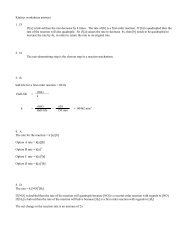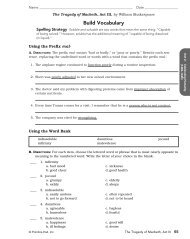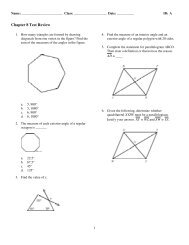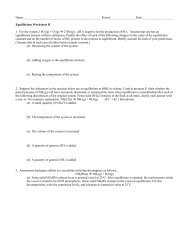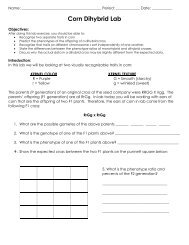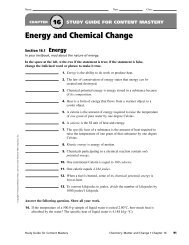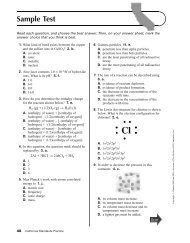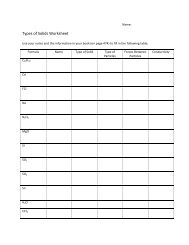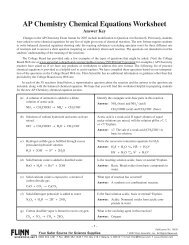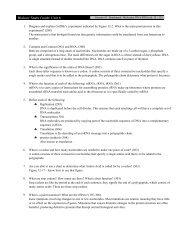Enthalpy and Hess's Law Lab - Oxford Academy
Enthalpy and Hess's Law Lab - Oxford Academy
Enthalpy and Hess's Law Lab - Oxford Academy
Create successful ePaper yourself
Turn your PDF publications into a flip-book with our unique Google optimized e-Paper software.
<strong>Enthalpy</strong> <strong>and</strong> Hess’s <strong>Law</strong> <strong>Lab</strong><br />
Introduction<br />
Every chemical reaction is accompanied by a change in heat. Thermochemical reactions include the heat of reaction as part of the<br />
equation. The heat released or absorbed in a reaction at constant pressure is the <strong>Enthalpy</strong> change (∆H rxn ) for the reaction. The enthalpy<br />
change for each reaction is unique to that reaction. Many values for ∆H rxn were experimentally determined, <strong>and</strong> many were calculated used<br />
Hess’s law. This lab will illustrate the principle of Hess’s law: if a reaction can be carried out in a series of steps, the sum of the enthalpies<br />
for each step equals the enthalpy change for the overall reaction. ∆H rxn = ∆H step1 + ∆H step2 . The three reactions that we will be using are<br />
as follows:<br />
Reaction 1:<br />
Reaction 2:<br />
Reaction 3:<br />
NaOH(s) + HCl(aq) NaCl(aq) + H 2 O(l)<br />
NaOH(aq) + HCl(aq) NaCl(aq) + H 2 O(l)<br />
NaOH(s) NaOH(aq)<br />
Since reaction 1 can be obtained by adding reactions 2 <strong>and</strong> 3, the ∆H rxn1 should equal ∆H rxn2 + ∆H rxn3 . At constant pressure ∆H rxn = q p .<br />
We cannot directly measure ∆H rxn or q p , but we can measure the change in temperature for a solution, <strong>and</strong> using the specific heat of the<br />
solution, <strong>and</strong> the grams of solution, we can find q p using the following equation:<br />
Equation 1:<br />
q = (grams of solution) x (specific heat of solution) x ∆T<br />
The heat that is released by the reaction will be absorbed by both the surroundings; in this case, the water in the solution <strong>and</strong> the<br />
calorimeter itself:<br />
Equation 2: q rxn = -(q solution + q calorimeter )<br />
Since every group’s calorimeter is slightly different, the heat capacity for the calorimeter will need to experimentally determine before it is<br />
used.<br />
Pre-<strong>Lab</strong> Questions<br />
1. Define ∆H rxn .<br />
2. Define specific heat, <strong>and</strong> heat capacity. How are these two terms different?<br />
3. The specific heat of a solution is 4.18 J/gK <strong>and</strong> its density is 1.02g/mL. The solution is formed by combining 25.0mL of solution<br />
A with 25.0mL of solution B, with each solution initially at 21.4C. The final temperature of the combined solutions is 25.3C.<br />
Calculate the heat of reaction, q rxn , assuming no heat loss to the calorimeter.<br />
4. If the calorimeter in the reaction above has a Heat Capacity of 8.20J/C, recalculate the q rxn , taking the heat loss to the calorimeter<br />
into account.<br />
5. If the reaction above between solutions A <strong>and</strong> B goes as follows: A(aq) + B(aq) AB(aq), <strong>and</strong> the molarity of A in solution A is<br />
0.60M, <strong>and</strong> the molarity of B in solution B is 0.60M, what is the enthalpy of reaction (∆H rxn ), for the formation of 1 mole of AB<br />
in solution. Express ∆H rxn in kJ/mol<br />
Materials<br />
NaOH(s) Digital Thermometer Distilled Water Calorimeter w/ Lid<br />
HCl(aq, 1.0M) Graduated Cylinder NaOH(aq, 1.0M) Magnetic Stirrer <strong>and</strong> Stir Bar<br />
250mL Beaker Balance<br />
Procedure<br />
Part 1: Determining the heat capacity of the Calorimeter<br />
1. Set up a calorimeter of two nested cups with a cover inside a beaker.<br />
2. Measure 50.0mL of room temp distilled water into the calorimeter.<br />
3. Place the calorimeter on a magnetic stirrer <strong>and</strong> add a stir bar, set the stir bar to stir slowly. (Alternatively, gently stir the solution<br />
with the thermometer.)<br />
4. Record the Temperature of the water in the calorimeter.<br />
5. Heat or obtain roughly 75mL of 70°C water.<br />
6. Measure out 50.0mL of this water using a graduated cylinder.<br />
7. Record the temperature of the hot water, <strong>and</strong> pour the hot water into the room temp water in the calorimeter.<br />
8. Cover the calorimeter <strong>and</strong> insert the thermometer.
9. Stir <strong>and</strong> record the temperature every 20 seconds for three minutes.<br />
10. Empty <strong>and</strong> dry the inside of the calorimeter, thermometer, <strong>and</strong> stir bar.<br />
Part 2: Determining the heats of Reaction<br />
Reaction 1: NaOH(s) NaOH(aq)<br />
1. Weigh out about 2.0g of NaOH(s). Record the actual weight.<br />
2. Add 100.0mL of room temperature water to the calorimeter.<br />
3. Start the stir bar <strong>and</strong> record the temperature of the water.<br />
4. Add the NaOH(s), <strong>and</strong> record the temperature once every 20 seconds, until it stops changing.<br />
5. Dump out the NaOH(aq) into the sink, rinse out, <strong>and</strong> dry the calorimeter, thermometer, <strong>and</strong> stir bar.<br />
Reaction 2: NaOH(aq) + HCl(aq) NaCl(aq) + H 2 O(l)<br />
6. Combine 50.0mL of 1.0M NaOH <strong>and</strong> 50.0mL 1.0M HCl, in the calorimeter,<br />
7. Record the temperature once every 20 seconds, until it stops changing.<br />
8. Dump out the solution into the sink, rinse <strong>and</strong> dry the calorimeter, thermometer, <strong>and</strong> stir bar.<br />
Reaction 3: NaOH(s) + HCl(aq) NaCl(aq) + H 2 O(l)<br />
9. Measure 50.0mL of Distilled water into the calorimeter.<br />
10. Add 2.0g of NaOH(s) (Record the actual weight) <strong>and</strong> 50.0mL of 1.0M HCl to your calorimeter<br />
11. Record the temperature once every 20 seconds, until it stops changing..<br />
12. Dump out the solution into the sink, rinse <strong>and</strong> dry the calorimeter, thermometer, <strong>and</strong> stir bar.<br />
Data<br />
Create a data table to hold all of your data for the 2 parts. Make sure you have a space for the initial <strong>and</strong> final temperatures, as well as the<br />
mass or volume for each reactant.<br />
Calculations<br />
Part 1<br />
1. Calculate ∆T hot water , ∆T room temp , <strong>and</strong> ∆T calorimeter for the reaction.<br />
2. The hot water transferred energy to the room temp water <strong>and</strong> the calorimeter. Use Equation 1 from above to determine q hot water<br />
<strong>and</strong> q room temp . The specific heat of water is 4.18J/g·C<br />
3. Use q hot water = -(q room temp + q calorimeter ) <strong>and</strong> q calorimeter = (heat capacity) x ∆T to calculate the heat capacity for the calorimeter.<br />
Part 2<br />
4. Calculate the amount of heat evolved in each reaction if we assume that all of the heat given off by the system was absorbed by<br />
the solution <strong>and</strong> the calorimeter.<br />
q rxn = -[heat absorbed by solution + heat absorbed by the calorimeter]<br />
q rxn = -[(grams of solution x specific heat of solution x ∆T solution ) + (C cal x ∆T solution )]<br />
You can assume the density of the final solution is 1.03g/mL <strong>and</strong> the specific heat of the solution is 4.18 J/g·C.<br />
5. Calculate the ∆H rxn for each reaction in kJ/mol.<br />
Part 3: Verifying Hess’s <strong>Law</strong><br />
6. Calculate the value for ∆H rxn for reaction 3 using the ∆H rxn for reactions 1 <strong>and</strong> 2.<br />
7. Calculate the % difference between the calculated <strong>and</strong> measured values for ∆H rxn for reaction 3.<br />
Discussion<br />
Conclusion



